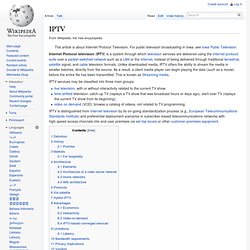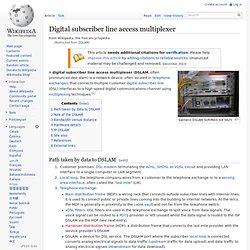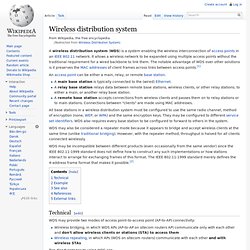

IPTV - Wikipedia. Internet Protocol television (IPTV) is a system through which television services are delivered using the Internet protocol suite over a packet-switched network such as a LAN or the Internet, instead of being delivered through traditional terrestrial, satellite signal, and cable television formats.

Unlike downloaded media, IPTV offers the ability to stream the media in smaller batches, directly from the source. As a result, a client media player can begin playing the data (such as a movie) before the entire file has been transmitted. This is known as Streaming media. IPTV services may be classified into three main groups: live television, with or without interactivity related to the current TV show;time-shifted television: catch-up TV (replays a TV show that was broadcast hours or days ago), start-over TV (replays the current TV show from its beginning);video on demand (VOD): browse a catalog of videos, not related to TV programming.
MPLS - Wikipédia. Origem: Wikipédia, a enciclopédia livre.

No contexto das redes de computadores e telecomunicações, o Multi Protocol Label Switching (MPLS) é um mecanismo de transporte de dados pertencente à família das redes de comutação de pacotes. O MPLS é padronizado pelo IETF - Internet Engineering Task Force através da RFC-3031 e opera numa camada OSI intermediária às definições tradicionais do Layer 2 (Enlace) e Layer 3 (Rede), pelo que se tornou recorrente ser referido como um protocolo de "Layer 2,5". O label é um identificador curto, de tamanho fixo e significado local. Todo pacote ao entrar numa rede MPLS recebe um label. Este pode ser pensado como uma forma abreviada para o cabeçalho do pacote. Descrições dos campos do Label[editar | editar código-fonte] O campo Label contém o valor atual deste: 1. 2. 3. 4.
Digital subscriber line access multiplexer - Wi... Siemens DSLAM SURPASS hiX 5625 A digital subscriber line access multiplexer (DSLAM, often pronounced dee-slam) is a network device, often located in telephone exchanges, that connects multiple customer digital subscriber line (DSL) interfaces to a high-speed digital communications channel using multiplexing techniques.[1] Path taken by data to DSLAM[edit] Role of the DSLAM[edit] xDSL Connectivity diagram The DSLAM equipment collects the data from its many modem ports and aggregates their voice and data traffic into one complex composite "signal" via multiplexing.

The aggregated traffic is then directed to a telco's backbone switch, via an access network (AN), also called a Network Service Provider (NSP), at up to 10 Gbit/s data rates. The DSLAM acts like a network switch since its functionality is at Layer 2 of the OSI model. Main distribution frame - Wikipedia. Like other distribution frames the MDF provides flexibility in assigning facilities, at lower cost and higher capacity than a patch panel.

The most common kind of large MDF is a long steel rack accessible from both sides. On one side, termination blocks are arranged horizontally at the front of rack shelves. Jumpers lie on the shelves and go through an insulated steel hoop to run vertically to other termination blocks that are arranged vertically. There is a hoop or ring at the intersection of each level and each vertical.
Installing a jumper requires two workers, one on each side. For the first half of the 20th Century, all MDF jumpers were soldered. Each jumper is a twisted pair. Some urban telephone exchange MDFs are two stories high so they don't have to be more than a city block long. The adoption of distributed switching in the late 20th century diminished the need for large, active, central MDFs.
Networking - TOC Cabling Standards Media And Co... When it comes to working with an existing network or implementing a new network, you need to be able to identify the characteristics of network media and their associated cabling.

This tutorial focuses on the media and connectors used in today's networks. In addition to media and connectors, this tutorial identifies the characteristics of the IEEE 802.3 standard and its variants. General Media Considerations In addition to identifying the characteristics of network media and their associated cabling, an administrator requires knowledge of some general terms and concepts that are associated with network media. Before looking at the individual media types, it is a good idea to first have an understanding of some general media considerations. Broadband Versus Baseband Networks employ two types of signaling methods: baseband and broadband. In terms of LAN network standards, broadband transmissions, on the other hand, use analog transmissions. Wireless Distribution System - Wikipedia. A wireless distribution system (WDS) is a system enabling the wireless interconnection of access points in an IEEE 802.11 network.

It allows a wireless network to be expanded using multiple access points without the traditional requirement for a wired backbone to link them. The notable advantage of WDS over other solutions is it preserves the MAC addresses of client frames across links between access points.[1] An access point can be either a main, relay, or remote base station. A main base station is typically connected to the (wired) Ethernet.A relay base station relays data between remote base stations, wireless clients, or other relay stations; to either a main, or another relay base station.A remote base station accepts connections from wireless clients and passes them on to relay stations or to main stations. Connections between "clients" are made using MAC addresses.